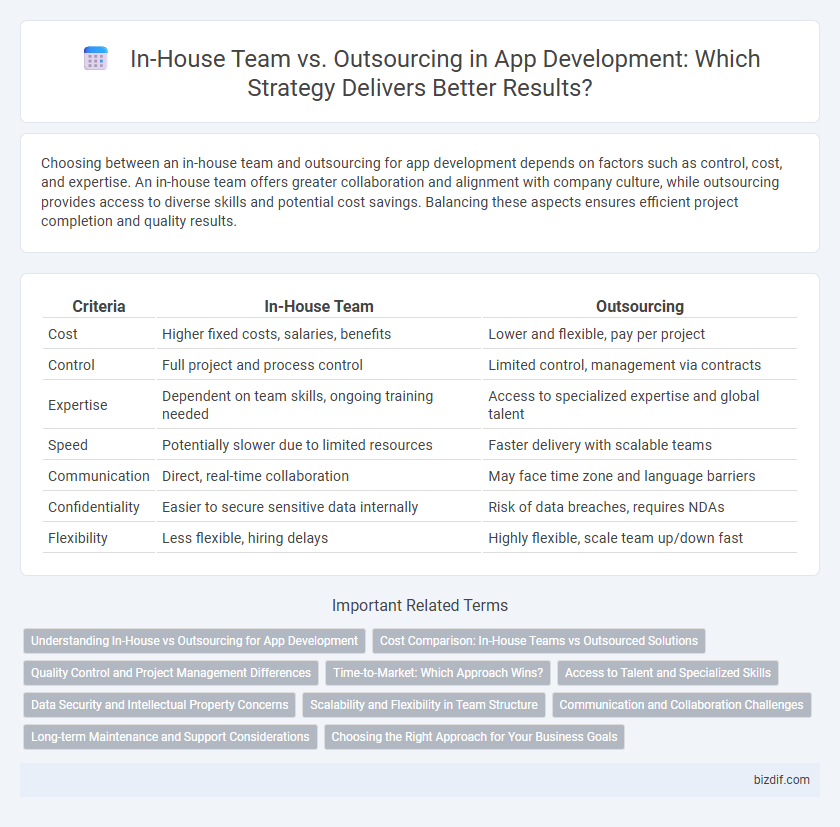Choosing between an in-house team and outsourcing for app development depends on factors such as control, cost, and expertise. An in-house team offers greater collaboration and alignment with company culture, while outsourcing provides access to diverse skills and potential cost savings. Balancing these aspects ensures efficient project completion and quality results.
Table of Comparison
| Criteria | In-House Team | Outsourcing |
|---|---|---|
| Cost | Higher fixed costs, salaries, benefits | Lower and flexible, pay per project |
| Control | Full project and process control | Limited control, management via contracts |
| Expertise | Dependent on team skills, ongoing training needed | Access to specialized expertise and global talent |
| Speed | Potentially slower due to limited resources | Faster delivery with scalable teams |
| Communication | Direct, real-time collaboration | May face time zone and language barriers |
| Confidentiality | Easier to secure sensitive data internally | Risk of data breaches, requires NDAs |
| Flexibility | Less flexible, hiring delays | Highly flexible, scale team up/down fast |
Understanding In-House vs Outsourcing for App Development
In-house app development teams provide greater control over project scope, direct communication, and alignment with company culture, enhancing product customization and iterative feedback. Outsourcing offers cost efficiency, access to specialized skills, and scalability, enabling faster project turnaround and flexible resource management. Choosing between in-house and outsourcing depends on project complexity, budget constraints, and long-term maintenance requirements.
Cost Comparison: In-House Teams vs Outsourced Solutions
In-house app development teams typically incur higher fixed costs due to salaries, benefits, and infrastructure, averaging $80,000 to $150,000 annually per developer. Outsourced solutions can reduce expenses by 30-50%, with hourly rates ranging from $20 to $70 depending on geographic location and expertise. However, hidden costs such as project management and communication overhead may affect total spending on outsourced projects.
Quality Control and Project Management Differences
In-house app development teams offer greater control over quality assurance processes, enabling real-time monitoring and immediate issue resolution, which enhances overall product reliability. Outsourcing requires robust project management tools and clear communication protocols to bridge time zone differences and align deliverables with quality standards. Effective collaboration between stakeholders is crucial to mitigate risks and ensure that project milestones are met without compromising on code quality or user experience.
Time-to-Market: Which Approach Wins?
In-house app development teams offer faster iteration cycles and enhanced collaboration, significantly reducing time-to-market due to immediate communication and dedicated resources. Outsourcing can introduce delays from time zone differences and coordination challenges, but access to specialized skills can accelerate specific development phases. Companies aiming for rapid launch often favor in-house teams to maintain agile workflows, while outsourcing suits projects requiring scalability or niche expertise without long-term resource commitments.
Access to Talent and Specialized Skills
Building an in-house app development team provides direct access to highly specialized skills tailored specifically to the company's needs, facilitating seamless collaboration and knowledge retention. Outsourcing app development offers access to a wider talent pool with niche expertise, often accelerating project timelines and reducing costs. Companies must evaluate the balance between long-term skill development and immediate access to specialized resources when choosing between in-house teams and outsourcing.
Data Security and Intellectual Property Concerns
Choosing an in-house app development team provides greater control over data security protocols and intellectual property management, reducing risks of breaches and unauthorized use. Outsourcing app development introduces vulnerabilities due to reliance on third-party vendors with varying security standards and potential exposure of proprietary code. Ensuring clear contractual agreements and robust encryption practices is essential when outsourcing to protect sensitive user data and safeguard intellectual property rights.
Scalability and Flexibility in Team Structure
An in-house app development team offers greater control and seamless collaboration, but scaling quickly often requires significant investment in hiring and training. Outsourcing provides enhanced flexibility by enabling access to a diverse pool of specialized developers on demand, facilitating rapid scaling without long-term commitments. Businesses prioritizing agility frequently choose outsourcing to adjust team size dynamically based on project phases and evolving requirements.
Communication and Collaboration Challenges
In-house app development teams benefit from direct, real-time communication that enhances collaboration and accelerates decision-making processes. Outsourcing introduces potential communication barriers such as time zone differences, cultural misunderstandings, and language limitations, which can delay project timelines and affect product quality. Effective collaboration tools and clear communication protocols are essential to mitigate these challenges in outsourced app development projects.
Long-term Maintenance and Support Considerations
Long-term maintenance and support require thorough evaluation of in-house teams versus outsourcing, as in-house developers offer deeper project familiarity and faster response times for updates and bug fixes. Outsourcing can provide access to specialized skills and cost-effective solutions but may introduce challenges in communication and continuity due to team turnover or time zone differences. Effective maintenance strategies prioritize consistent knowledge transfer, documentation, and scalable support frameworks to ensure sustained app performance and user satisfaction.
Choosing the Right Approach for Your Business Goals
Selecting the right app development method hinges on aligning team structure with business objectives and resource availability. In-house teams offer greater control, seamless communication, and deep alignment with company culture, ideal for long-term projects requiring continuous iteration and proprietary knowledge. Outsourcing provides access to specialized skills, scalability, and cost-efficiency, making it suitable for shorter timelines or projects demanding diverse technical expertise.
In-house team vs Outsourcing Infographic

 bizdif.com
bizdif.com